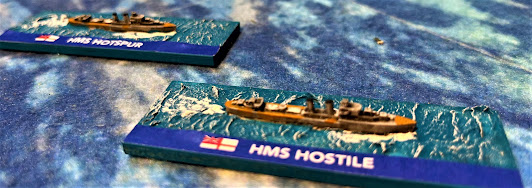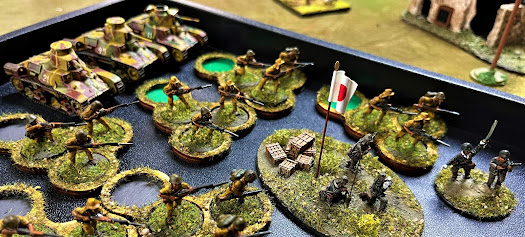Readers of this blog and other fora where I post regularly could be forgiven for thinking I only ever play BBB. Actually that's not the case at all, I regularly sample different wargames across different periods and scales. January has been particularly rich in this respect. In the course of a four-day holiday gaming weekend I got to play:
As a rules author myself, I try to steer clear of commenting on others' rulesets, so let me limit myself here to saying that all the games were good fun and justified their inclusion in the weekend's agenda.
No profound reflections this time, just a selection of photos to give a taste of the range of games and a look at my friends' nice figures.
Classic wargamer fare: d'Erlon's attack on the Allied left at Waterloo, played with General d'Armee. The British line waits as the French I Corps rolls forward past La Haye Sainte. Old Nosey himself right of pic close to his elm tree (out of shot).
The Dutchmen of Bylandt's brigade about to take their customary pounding before our French right hook inside Papelotte rolled up the Allied line. 15mm figures from Rob's collection.
Wars of the Roses action using Test of Resolve. Mark F's 28s. I took the role of the Duke of Somerset at the battle of Hexham, with his stirring warcry of "orroight moy luverr" (with apologies to our West Country readers).
The two destroyers I commanded in scenario 1 of Mark's 2-scenario Narvik mini-campaign using Fire at Sea. Our British team managed to change history - oops. Maybe I should stick to land battles.
Our O Group game was an in-person edition of the Tai'erzhuang remote game I reported on a year ago. This gave me the chance to admire CB's beautiful armies up close. Here we see some of his Chinese with their eclectic assortment of equipment from various obliging arms dealers ... ... and their foes, the sons of Nippon.
Had to dedicate a pic to this exotic beast, the Japanese SS-Ki flamethrower tank, behind its more conventional friend, the Type 89 I-Go. Not to be outdone, the Chinese fielded these gorgeous little amphibious tanks. $50 a model, CB said. For some reason he was not impressed by my suggestion that he should get duplicates and cut them down for when the tanks are swimming.
A splendid red line of British regulars at Saratoga. Scott's 28s.
Upstart rebels preparing to live free or die.
The battle of Freeman's Farm (Saratoga) kicks off.
Professor Murray's map game used two maps covering the two theatres of operations in Italy and Germany. He uses this to train US staff officers. It highlights problems such as cooperation with allies, the importance of the changing political context, logistics, sieges, weather, and other aspects that don't often make it onto wargames tables. Here we see matters come to a head in the Po valley as the massed French field armies give the Austrians a bloody nose, while a small French force upper right menaces allied supply lines, dragging big Allied stacks away from the main action. BBB players may guess at the genesis of the combat results table at bottom left.

And this is the Germany map. The green stripe down the left part is the Rhine valley; the white patch along the bottom of it is the mountains of northern Switzerland. Little discs are fortress garrisons, big stacks are field armies (blue = French, grey = Austrian, green = Russian.) Not sure what happened here as I was fighting in Italy, but I think the French have repelled an aggressive Austrian incursion and wiped out an Austrian army.
Tonight's entertainment will be something different again: Seven Years War, the battle of Kolin, using the Kriegskunst rules. More on that in due course, no doubt.













A fine pot pourri of games, scales and figures there Chris!
ReplyDeleteI am very fortunate in my friends, Steve!
DeleteGreat article! With the Waterloo game, I am assuming 15mm, but what was the figure scale and base sizes? I ask as I want to use BBB for ‘big’ battles, but am looking for some granular tactical rules for Divisional and lower scraps. Need the same basing style for both. Love BBB btw - excellent rules set.
ReplyDeleteYes, 15mm. The bases were quite dinky - maybe 1/2"? Perhaps 1" bases would work; perhaps you'd just have to call them double bases The game was perhaps a bit ambitious for GdA - a dozen brigades a side, resolving combat by individual battalions - but GdA could well have the tactical granularity you're after for a large division game.
Delete